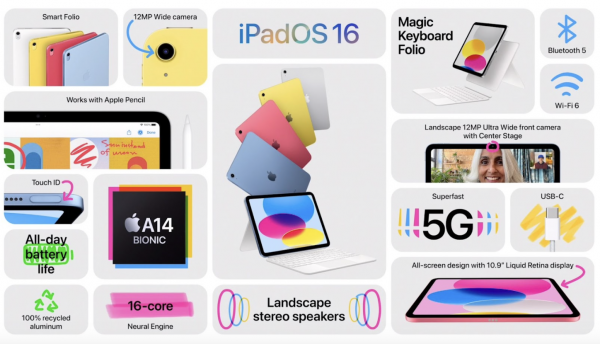This was an interesting year for Apple. Supply chain issues had a serious impact upon the company as global pandemic issues made manufacturing and shipping goods a challenge. We had millions of dollars of backorders for government orders at one time and Apple saw the impact of covid lock-downs in China and elsewhere. Nevertheless, defying the analyst's most dire predictions, Apple posted record sales and profits during the year.
Apple started out the year by announcing their 1st quarter earnings in January and they posted their first $10 billion sales quarter. In the old days, January saw MacWorld Expo and Consumer Electronics shows and many new product announcements. While CES is back this year, it is not a big show for Apple. Apple started the year with some product introductions in March including the Mac Studio. 
and the Mac Studio Display.

The iPhone SE gained the powerful A15 Bionic chip and the fifth generation iPad Air moved to the M1 chip, too. Btw, Apple also used that event to annonuce that Apple TV would be carrying Friday night baseball as Apple entered the competition for sports events.
April brought a significant event as Apple finally relented and began to start allowing users to fix some of its devices in 2022. Apple began by allowing U.S.-based customers to repair their iPhones by replacing some damaged parts. Apple later expanded this program in August to include some MacBook models.
May saw the somewhat sad death of the iPod as Apple discontinued the iPod Touch, the last remaining iPod. I remember when Steve Jobs introduced the original iPod and I have to admit, I was one of the skeptics, saying who needs another MP3 player but millions of iPods later, it was sort of sad to see the last iPod hit the vintage list.

June is World Wide Developers Conference and that means software! Apple released the first developer betas for iOS 16, iPadOS 16, macOS Ventura, and watchOS 9. It wasn't all software as Apple introduced the redesigned MacBook Air M2 and the "new"13-inch MacBook Pro (2022). It is the same 13-inch MacBook Pro from 2020 but with a more efficient M2 chipset.

The rest of the summer was spent outdoors in the sun or working hard for the September announcements!

Apple started off the September party with not just one new Apple Watch, but three! The second-generation Apple Watch SE provides a better entry-level option, the Apple Watch Series 8 takes over as the flagship model, and the Apple Watch Ultra brings new capabilities to extreme athletes, adventurers, and the rest of us wannabes.
Most interesting is the new Apple Watch Ultra. It’s a completely new design with a 49mm titanium case and a flat sapphire front crystal embedded in the case to protect against side impacts. It features a new Action button that apps can use for their own purposes, along with a larger Digital Crown and side button to make it easier to control with gloves. The Always-On screen is brighter than ever, making it readable in direct sunlight. The larger size also gives it better battery life, with 36 hours in normal usage and up to 60 hours with an extended battery optimization mode Apple says is still coming.
Apple beefed up other specs in the Apple Watch Ultra as well. A new dual-frequency GPS works better in conditions that can block GPS signals. It includes dual speakers and a three-mic array for better audio output and input, even in windy conditions. If you need help being found in the wilderness, it boasts an 86-decibel siren that can be heard up to 180 meters away. It’s IP6X dust resistant and meets the US military standard MIL-STD 810H for environmental conditions. You can even take it diving down to 100 meters, and with the Oceanic+ app coming in a few months, the Apple Watch Ultra can act as a full dive computer.
Everyone likes new iPhones and the iPhone 14 was no exception. With the new iPhones, Apple made a clean split between the regular and Pro models. On the lower end, Apple has the 6.1-inch iPhone 14 and the 6.7-inch iPhone 14 Plus—there is no iPhone 14 mini. On the high end, Apple pulled out all the stops for the iPhone 14 Pro and iPhone 14 Pro Max, again in those 6.1-inch and 6.7-inch sizes. Design-wise, the models are extremely similar to the iPhone 13, with squared-off sides and only very slight size changes.
More innovative—and present in both the regular and Pro models—are a pair of technologies we sincerely hope you never have to use. Crash detection relies on a variety of sensors in the iPhone to detect the changes in acceleration, air pressure, and sound that accompany car crashes. In the event of a crash, the iPhone’s Emergency SOS feature offers to call emergency services and notify your emergency contacts.
Even more technologically impressive is Emergency SOS via satellite, which enables very low bandwidth text message communication with emergency services using satellites when there’s no cellular coverage. The feature will help you point your iPhone at fast-moving satellites overhead, and it asks vital questions to distill key facts for emergency responders because even short messages may take over a minute to get through. More commonly, you’ll be able to manually share your location via satellite using Apple’s Find My system when you’re without cellular or Wi-Fi connectivity.
Apple’s final change to both the regular and Pro models—at least in the US—is a switch to eSIM. None of the iPhone 14 models sold in the US will have SIM slots.
And lastly, Apple introduced the Airpod Pro 2nd gen. Both the earbuds and the charging case look essentially the same, with the main subtle external change being that you can now adjust the volume with light swipes up and down on the stems of the AirPods Pro. A new extra small ear tip should make the AirPods Pro fit more people’s ears.
October brought a few more announcements with a new iPad, iPad Pro and Apple TV

Apple announced upgrades to the iPad, iPad Pro, and Apple TV. The new models are largely evolutionary, with changes that are welcome but unlikely to change your iPad or Apple TV experience.
October saw the release of Apple's 4th quarter and annual financial results and short sellers and doom sayers were predicting dire results but once again Apple beat the street posting revenue of $90.1 billion and net quarterly profit of $20.7 billion, or $1.29 per diluted share, compared to revenue of $83.4 billion and net quarterly profit of $20.6 billion, or $1.24 per diluted share, in the year-ago quarter.
It was a challenging year with pandemic, war, economic chaos but Apple remained a powerful player continuing to innovate and bring amazing technology to us! I can't wait to see what they have in store for 2023!